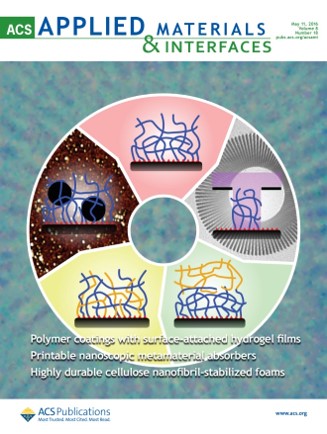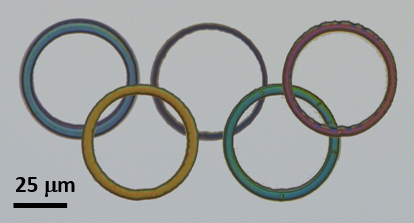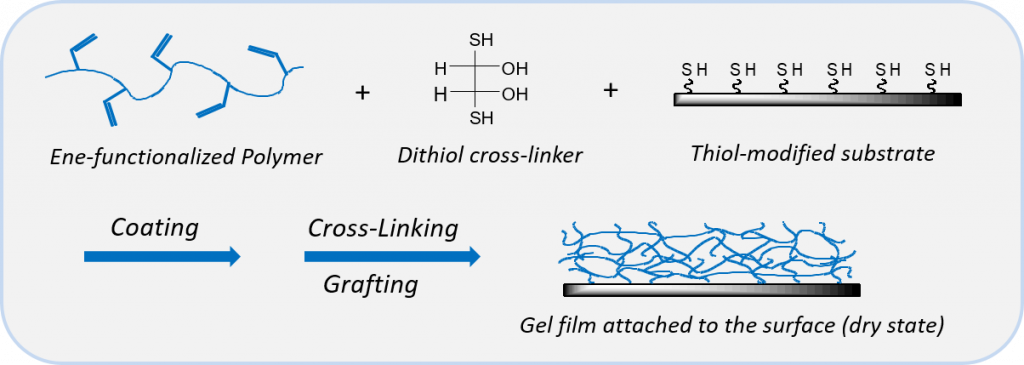


The micrometric Olympic Rings are made with surface-attached hydrogels. The colors of the rings correspond to Newton’s interferences.
The various architectures of surface-grafted hydrogels are illustrated on the cover of ACS-AMI journal.
Hydrogel films are networks of hydrophilic polymers cross-linked to each other and grafted onto a substrate. Hydrogel thin films have the advantage of being multi-scale and multi-functional. The network structure provides an additional degree of freedom in the direction perpendicular to the substrate. Hydrogel films therefore allow for greater variability, in terms of thickness, architecture and stimulable properties.
We have proposed a simple, efficient and flexible approach that does not require sophisticated chemistry, called CLAG (Cross-Linking And Grafting), which consists in cross-linking and grafting the preformed chains by click chemistry. Covalent grafting onto the substrate and chemical cross-linking between chains ensure high chemical and mechanical stability. The great simplicity and flexibility of this approach allows it to be easily generalized to various inorganic substrates (oxide or metal) and to many hydrophilic polymers (stimuli-responsive, biocompatible…). We have shown that it is possible to fabricate hydrogel films on a very wide range of thicknesses, from a few nanometers to ten micrometers and more, with custom-made architectures, which opens new perspectives compared to existing thin films.

The Cross-Linking And Grafting (CLAG) strategy for the synthesis of surface-attached hydrogel films
Les films d’hydrogels sont des réseaux de polymères hydrophiles réticulés entre eux et greffés sur substrat. Les films minces d’hydrogels présentent l’avantage d’être multi-échelle et multi-fonction. La structure de réseau apporte un degré de liberté supplémentaire dans la direction perpendiculaire au substrat. Les films d’hydrogels permettent donc une plus grande variabilité, en terme d’épaisseur, d’architecture et de propriétés stimulables.
Nous avons proposé une approche simple, efficace et flexible qui ne nécessite pas de chimie sophistiquée, dite CLAG (Cross-Linking And Grafting), qui consiste à réticuler et greffer les chaînes préformées par chimie click. Le greffage covalent sur le substrat et la réticulation chimique entre chaînes assurent une grande stabilité chimique et mécanique. La très grande simplicité et flexibilité de cette approche permet de la rendre facilement généralisable, à divers substrats inorganiques (oxyde ou métal) et à de nombreux polymères hydrophiles (stimulables, biocompatibles…). Nous avons montré qu’il est possible de réaliser des films d’hydrogels sur une très large gamme d’épaisseurs, allant de quelques nanomètres à la dizaine de micromètres et plus, avec des architectures à façon, ce qui ouvrent de nouvelles perspectives par rapport aux couches minces existantes.

Li, M.; Bresson, B.; Fretigny, C.; Cousin, F.; Tran, Y. Submicrometric films of surface-attached polymer networks: temperature-responsive properties. Langmuir 2015, 31, 11516-11524.
https://doi.org/10.1021/acs.langmuir.5b02948
Chollet, B.; Li, M.; Martwong, E.; Bresson, B.; Fretigny, C.; Tabeling, P.; Tran, Y. Multiscale surface-attached hydrogel thin films with tailored architecture. ACS Appl. Mat. Interfaces 2016, 8, 11729-11738.
https://doi.org/10.1021/acsami.6b00446
Chollet, B.; D’Eramo, L.; Martwong, E.; Li, M.; Macron, J.; Mai, T. Q.; Tabeling, P.; Tran, Y. Tailoring patterns of surface-attached multi-responsive polymer networks. ACS Appl. Mat. Interfaces 2016, 8, 24870–24879.
https://doi.org/10.1021/acsami.6b07189
Martwong, E.; Tran, Y.Lower Critical Solution Temperature phase transition of poly(PEGMA) hydrogel films. Langmuir 2021, 37, 8585-8593.
https://doi.org/10.1021/acs.langmuir.1c01165
Kopecz-Müller, C.; Gaunand, C.; Tran, Y.; Labousse, M.; Raphaël, E.; Salez, T.; Box, F.; McGraw, J.D. Swelling and evaporation determine surface morphology of grafted hydrogel thin films. Langmuir 2025, 41, 2400-2410.
https://doi.org/10.1021/acs.langmuir.4c04025
